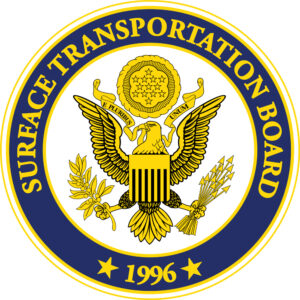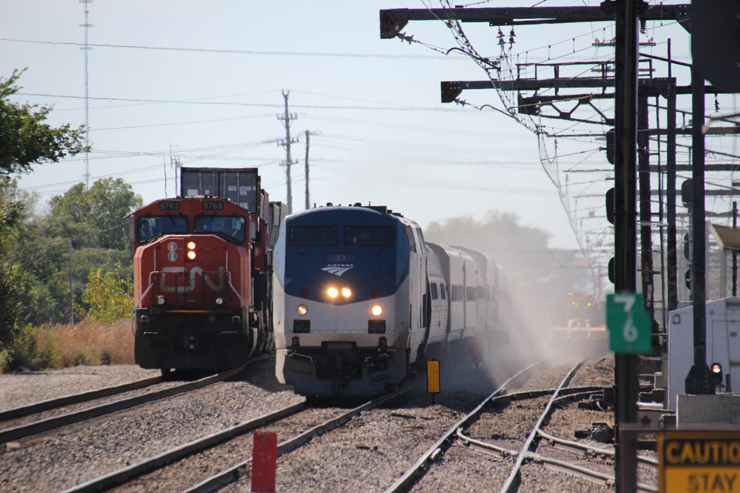 WASHINGTON – Federal regulators have ordered Class I railroads to provide more detailed operational and staffing metrics and will require the big four U.S. systems to submit service recovery plans in light of widespread service problems that were spotlighted during hearings last week.
WASHINGTON – Federal regulators have ordered Class I railroads to provide more detailed operational and staffing metrics and will require the big four U.S. systems to submit service recovery plans in light of widespread service problems that were spotlighted during hearings last week.
The Surface Transportation Board, in a decision issued on Friday, said “immediate action is needed to address the significant service problems” as rail service has worsened this year.
“Our freight rail service hearing highlighted the grave concerns of shippers and others regarding freight rail service,” Chairman Martin J. Oberman said in a statement. “While the railroads have faced certain challenges over the last few years, the evidence produced at last week’s hearing is overwhelming that the railroads’ longstanding practice of reducing operating ratios by cutting employment levels, mothballing locomotives, and eliminating other essential resources are the central reasons why farmers have been hours away from depopulating herds, manufacturing facilities have reduced operating hours, and shippers cannot get their products to market on time or receive essential raw materials for their companies. These failures are harming the nation’s economy and, in my view, are contributing to the inflationary forces affecting food and fuel in particular.”
All Class I railroads will have to provide much more detailed performance metrics every week for the next six months. The railroads already report a range of data weekly, but the board said it needed more information in order to get a better idea of the extent of congestion, service failures, and the impact of crew and locomotive shortages.
Among the data sought: Dwell information for smaller terminals; the weekly average number of train starts per day, broken down by train type; detailed freight car information, including the number of miles cars travel per day; and the weekly average number of trains that must be recrewed due to the federal hours of service law, along with the recrew rate.
The board also ordered the railroads to provide data regarding their local service, something that shippers have long sought. The railroads will have to report the number of local trains canceled per day and week as well as the percentage of scheduled spots and pulls fulfilled at customer facilities, broken down by operating division.
The railroads also must provide the percentage of manifest cars and unit trains delivered within 24 hours of the original estimated time of arrival.
The board directed all of the Class I railroads to submit more detailed monthly employment reports, including the number of train crews in active service and on extra boards.
BNSF Railway, CSX Transportation, Norfolk Southern, and Union Pacific were ordered to submit service recovery plans by May 20 and service progress reports beginning on June 3. And for the next three months they’ll also have to participate in biweekly calls with STB staff to provide updates on efforts to improve service.
The plans must detail what the railroads are doing to alleviate crew shortages and how they will avoid them in the future.
The STB also waded into operations in its order covering railroads’ service recovery plans. Labor leaders last week were critical of the use of energy management systems such as Trip Optimizer, as well as speed and throttle restrictions railroads have placed on some trains and in some operating territories.
“In light of suggestions on this record that reductions in velocity have contributed to congestion and train delays, the Board expects each carrier within its service recovery plan to report on any plans it has to lift current velocity restrictions, as well as any plans it has to increase the power on its through trains — and not to limit the use of that power — so that each such train has the capacity to travel at track speed. To the extent a carrier has no such plan to lift velocity restrictions or increase power, the Board expects the carrier to explain why,” the decision reads.
Labor leaders told the board that the speed restrictions extend transit times and lead to more trains requiring recrews while en route. Rail operating officials disagreed, saying systems like Trip Optimizer reduce fuel use while keeping the railroad fluid because they are linked with dispatching systems that have a bird’s eye view of the entire railroad.
Oberman warned that the Friday decision may not be the last regarding rail service.
“Requiring additional reporting from railroads may not be the final result of our hearing on service issues,” Oberman said. “Today’s decision is an immediate step the Board can take to enable needed monitoring of the improved efforts the railroads have been promising for months, and to determine if additional regulatory steps are necessary to promote reliable service.”














I guess because Engineers like to be paid 52 weeks a year. Will your engineers be paid while sitting on the bench?
As explained to me by an airline pilot this weekend…..the pilots that were furloughed for so long went and got other jobs and wont come back. The ones that were close to retirement, did so and won’t be coming back.
It takes a long time to get a pilot up and going. Virgin Airlines recently ran into a problem where a co-pilot was found to have not passed his final certification flight. His Captain was not certified to train and support his certification, so the plane (London to NYC) had to turn back over Ireland because it violated safety standards. It took Virgin almost 3 hours to find a set of pilots that wouldn’t expire over the Atlantic.
So I see the same in the railroad business. PSR caused massive reductions of yard staff and engineers. Most found new jobs, many retired. That means they have to completely train a new generation before they can put them behind a lever.
It’s too bad railroads can’t get smarter about their resources. They gladly pool to own common railcars, they purchase motive power from each other all the time, they purchase joint ownership of many city railroads, while can’t they create pool of talent to pay to keep on the bench for these cyclical or market driven events? Make that talent available to *any* railroad through a joint owned entity. Call them contractors , call them what ever, work with the unions to structure the talent pool so that it doesnt create labor unrest.
If your railroad uses EMD, and you need some EMD trained staff, check the pool. If you are UP and need a driver used to left hand operations around Chicago, check the pool. If the union certifies their work ability and running a train is becoming a commodity, the pool the resources.
Railroads lease hired gun engines all the time from GATX and others when needed to fill gaps, why not with engineers?
As a retired train dispatcher, trains running track speed is great as long as they have somewhere to go. Across the country too many yards are clogged building two to three mile long trains. Too many sidings are blocked with trains being held out of yards or waiting for crews.
Sad thing is, not much will change. Too many lobbyists and lawyers.
STB should be careful what it demands re: service recovery v. train velocity – “…report on any plans it has to lift current velocity restrictions, as well as any plans it has to increase the power on its through trains — and not to limit the use of that power — so that each such train has the capacity to travel at track speed.”
It would be a simple matter for RRs to start lowering track speeds to comply. It’s long been known that fuel savings increase and track maintenance costs decrease when train speeds are lowered.
Supposedly Mr. Sears, but I really think it means keep Wall Street happy.
Precision Scheduled Railroading. Presumably that means having a workable, fully resourced, plan that meets your customers’ needs?
Supposedly Mr. Sears, but I really think it means keep Wall Street happy.
“Requiring additional reporting from railroads may not be the final result of our hearing on service issues,” Oberman said. “Today’s decision is an immediate step the Board can take to enable needed monitoring of the improved efforts the railroads have been promising for months, and to determine if additional regulatory steps are necessary to promote reliable service.”
“[A]dditional regulatory steps”. Sounds like Oberman might just be ready to make the Class 1s lie in the bed they made
JAY BURNS —- Oberman has the railroad CEOs peeing in their underwear waiting for him to drop the hammer.
Today’s railroads remind me of the Big Three Detroit auto companies in the 1970’s, especially the company (which I won’t identify) named after the I-375/ I-75 Freeway, the company then headquartered in a Michigan city I won’t name that rhymes with “Buy Land Shark”. No matter how badly the company screwed up it kept getting worse.
Every vacant lot in Detroit in the 1970’s was parked solid with dung-colored autos this company built but the dealers didn’t want. The solution to its problem: — keep doing the same thing and hope nobody would label it a problem.
I worked for Union Pacific for 42 years. Here’s my suggestion.call any major carrier and request to ship a carload. Good luck!
Well we shall see what happens……. Yesterday on the railroad I work for there was about 40 miles of dead trains, from a town in the Mojave desert called ludlow all the way to dagget California just east of Barstow. All trains with no crews and none available.
As if shippers and receivers play no part in the service issues? I’m looking directly at the none 24/7 operations, if you’re going to complain about the service you receive, then perhaps your operations should match those of the service provider before you cry fowl…not that the STB is that smart to pair the two together.
“… cry FOWL …”? Is that a veiled reference to chickens coming home to roost?
To use an old expression where I came from, “they’ve been taken to the woodshed”. Anybody know the meaning of that?
Yes, Al, I do. And I truly hope the CEOs and COOs and other BOZOs get the whuppin’ they deserve.
The chickens are coming home to roost. Let the tap dance begin.
We can only hope, Mr. Wayman. These CEOs and EVPs, are addicted to PSR and all the things that follow from that addiction. And the stockholders have blinders on and care not a whit about service levels. They are impressed only by lower ORs (read headcount reductions) and rising share prices. How can we cure that PSR addiction? Ain’t gonna be easy if for no other reason that they’ve run off all the train crews with their institutional knowledge.